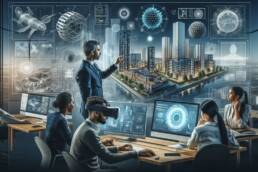Have you ever stumbled upon a picture of a new building and found yourself pausing, your mind whirling with the thought, “Wow, I can’t believe it’s not real yet!”? This moment of astonishment is brought to you by the magic of 3D architectural rendering. It’s a fascinating blend of technology and vision, where architects no longer just tell us but can show us what their ideas will look like in the real world, even before a single brick is laid down. This is where dreams start to take on a form, where the lines between imagination and reality blur, giving us a glimpse into the future.
Imagine being able to see the reflection of the sky on the glass facade of a skyscraper that doesn’t yet exist, or walking through the halls of a building that is currently just an idea in someone’s mind. This isn’t just about creating buildings; it’s about envisioning new spaces where people will live, work, and play. It’s about bringing to life the unseen and giving shape to the future, piece by piece. In this amazing world where technology meets creativity, architects use their tools not just to design spaces, but to tell stories, evoke emotions, and inspire awe.
Let’s delve deeper into this captivating realm, exploring how 3D architectural rendering is revolutionizing the way we see, understand, and interact with our future environments. From the spark of an idea to the final touch in a virtual landscape, we’re about to uncover the journey of creation like never before. Welcome to the pioneering world of 3D architectural rendering, a place where imagination is the only limit.
From Paper to Pixels: A Quick History
In the journey from the initial sketches on paper to the sophisticated digital models we see today, the world of architectural design has undergone a remarkable transformation. This voyage from paper to pixels encapsulates not just a change in tools but a revolutionary shift in how architects visualize and share their visions. Let’s take a closer look at this fascinating history.
1. The Era of Paper and Pencil
For centuries, the architect’s primary tools were simple yet powerful: paper and pencil. With these, they crafted detailed blueprints that laid the groundwork for every type of building imaginable. These drawings required immense skill and precision, as they were the sole visual representation of what was to be built. Changes to the design were time-consuming and often involved starting from scratch, making the design process slow and meticulous.
2. The Dawn of Digital Design
The digital revolution began to take root in the late 20th century, forever altering the landscape of architectural design. Computers introduced new possibilities for creating and manipulating designs. The introduction of Computer-Aided Design (CAD) software in the 1980s was a pivotal moment. For the first time, architects could draft designs digitally, opening the door to easier revisions and more complex geometries.
3. The Evolution of 3D Modeling
As technology advanced, so too did the capabilities of architectural software. From the static 2D blueprints of CAD, the industry moved towards dynamic 3D modeling. Tools like AutoCAD, SketchUp, and Revit allowed designers to create detailed three-dimensional representations of their work. This shift to 3D was monumental, offering a more holistic view of architectural projects and enabling architects to explore their designs in virtual space.
4. The Impact of Visualization Technologies
The introduction of visualization and rendering software added another layer to the design process. Architects could now imbue their models with textures, lighting, and environmental effects, bringing them to life in unprecedented detail. This leap forward made it possible to present designs in a way that was both visually stunning and incredibly detailed, closely mimicking real-life appearances.
5. The Present and Future: Virtual Reality and Beyond
Today, the journey from paper to pixels continues with the advent of virtual reality (VR) and augmented reality (AR) technologies. These tools allow architects and clients to walk through virtual models of buildings, experiencing the space in a fully immersive way before any real-world construction begins. The future promises even more advancements, with AI and machine learning poised to automate and enhance many aspects of the design process.
6. Reflecting on the Journey
The transformation from paper to pixels has not only changed the tools architects use but has expanded the very boundaries of architectural imagination. Designs that once would have been impossible to convey on paper can now be explored in meticulous detail, shared across the globe in moments, and experienced as if they were already built. This evolution speaks to the endless potential for innovation in architectural design, a field that continues to dream big and push the limits of what’s possible.
Toolbox That Builds Dreams
Diving deeper into the toolbox that architects use to build dreams in the digital world, we find that these tools are more than just software; they are gateways to realizing the impossible. The evolution of architectural tools from physical to digital has not only streamlined the design process but also expanded the realm of creative possibilities. Let’s explore these tools in more detail.
1. AutoCAD: The Foundation Stone
AutoCAD, developed by Autodesk, is often considered the bread and butter of the architectural world. It was one of the first CAD programs available on personal computers, revolutionizing the way architects design. With AutoCAD, precision in creating detailed 2D drawings and 3D models became achievable. It’s the foundational software that many architects learn first, enabling them to draft, annotate, and design with exactitude. AutoCAD’s versatility makes it suitable for a wide range of projects, from small residential designs to complex urban planning.
2. SketchUp: Bringing Ideas to Life
SketchUp stands out for its user-friendly interface and extensive library of models. It’s a tool that allows architects to quickly bring their ideas to life in 3D. SketchUp is favored for its ease of use, making it possible for even beginners to create detailed models with textures and animations. The software also offers an extensive online library called 3D Warehouse, where users can find and share models, further simplifying the design process. SketchUp is often used for initial concept modeling because it enables architects to explore various design options with speed and flexibility.
3. Revit: Building Information Modeling Powerhouse
Revit takes architectural design a significant step further by focusing on Building Information Modeling (BIM). Unlike traditional CAD software, Revit is all about creating intelligent 3D models that carry detailed information about every component of the building, from materials to spatial relationships. This allows for a holistic approach to building design and management, facilitating better decision-making and efficiency throughout the construction process. Revit is instrumental in collaboration among architects, engineers, and construction professionals, ensuring that all aspects of a project are aligned and integrated from the start.
4. Rhino: The Shape Shifter
Rhinoceros (Rhino) is renowned for its mathematical precision in creating and manipulating complex shapes and surfaces. It’s particularly favored for projects that require non-standard geometries, thanks to its powerful NURBS (Non-Uniform Rational B-Splines) modeling. Rhino is also highly compatible with other software through file exports, making it a versatile tool in an architect’s arsenal for both design and analysis.
A New Way to See Buildings
The revolution brought about by 3D rendering in the architectural world has not just changed the way architects design but also transformed how everyone else perceives and interacts with future buildings. This technology has ushered in a new era of visualization, making the process of designing, reviewing, and modifying architectural projects more intuitive and engaging than ever before.
1. Visualizing the Unbuilt
Imagine trying to understand the complexity of a building through flat, two-dimensional drawings. This method requires a lot of imagination and technical knowledge, often leaving clients and the general public struggling to visualize the final product. 3D rendering has bridged this gap by providing lifelike representations of architectural projects. These renderings can showcase buildings in photorealistic detail, from the texture of the materials to the interplay of light and shadow throughout the day. This level of detail makes it easier for everyone involved, not just professionals, to understand the vision behind a project and see what the building will look like once it’s built.
2. Interactivity and Engagement
Beyond static images, modern 3D rendering and visualization technologies offer interactive experiences. Tools such as 360-degree views and virtual walkthroughs allow clients to explore the nooks and crannies of a building before the foundation is even laid. This interactivity is not just impressive; it’s incredibly useful. It enables clients to provide feedback based on an accurate representation of the space, leading to designs that better meet their needs and expectations.
3. Making Informed Decisions
With the advent of 3D rendering, making changes to a design no longer requires a return to the drawing board in the literal sense. Architects can tweak and adjust models with a few clicks, allowing for rapid iterations. This flexibility makes it possible to explore different design options and solve problems early in the design process, saving time and resources. It also empowers clients to make informed decisions, as they can see the implications of their choices in real time.
4. Enhancing Communication
One of the significant challenges in any construction project is ensuring that everyone involved has the same understanding of the project. 3D renderings serve as a universal language, bridging the gap between technical architectural plans and the layperson’s understanding. They enhance communication between architects, clients, contractors, and other stakeholders, ensuring that everyone is on the same page throughout the project.
What’s Next for 3D Rendering?
The horizon of 3D rendering is expanding at an unprecedented pace, with innovations that promise to further revolutionize the architectural landscape. As we look towards the future, several emerging technologies and trends are set to redefine the boundaries of architectural visualization, making the process more immersive, efficient, and accessible than ever before.
1. Virtual Reality (VR) and Augmented Reality (AR)
Virtual Reality (VR) and Augmented Reality (AR) are on the cusp of transforming architectural rendering from a passive viewing experience into an interactive exploration. VR immerses users completely in a digital world, allowing them to walk through and interact with virtual buildings as if they were real. AR, on the other hand, overlays digital information in the real world, offering a unique blend of reality and virtual detail. These technologies not only make it possible to experience unbuilt environments but also enable architects and clients to experiment with design elements in real time, fostering a collaborative and dynamic design process.
2. Artificial Intelligence (AI) and Machine Learning
Artificial Intelligence (AI) and Machine Learning are set to automate and optimize many aspects of the 3D rendering process. AI can help in generating photorealistic images more quickly by learning from a database of images and applying those learnings to new renderings. This could significantly reduce the time and effort required for creating detailed visualizations. Moreover, AI could assist in the design process itself, offering suggestions for optimizing space, lighting, and materials based on vast datasets of architectural knowledge.
3. Cloud Computing and Collaborative Platforms
Cloud computing is making high-powered rendering more accessible to architects and designers everywhere, removing the need for expensive hardware. By leveraging cloud-based rendering solutions, the processing power required to generate complex visualizations can be outsourced to remote servers, enabling faster turnaround times and collaboration across geographic boundaries. This democratization of rendering capabilities encourages more firms, regardless of size, to adopt advanced visualization techniques.
4. Sustainable and Responsive Design
As sustainability becomes increasingly crucial in architecture, 3D rendering is evolving to incorporate environmental considerations into the design process. Future tools may provide real-time feedback on a building’s energy efficiency, carbon footprint, and environmental impact, allowing architects to create designs that are not only visually appealing but also eco-friendly. Additionally, responsive design elements that adapt to changing environmental conditions can be explored and tested virtually, promoting innovation in sustainable architecture.
5. 3D Printing and Construction
The convergence of 3D rendering with 3D printing technology is paving the way for new construction possibilities. Architectural models rendered in 3D can now be brought to life through 3D printing, allowing for rapid prototyping and even the construction of building components. This synergy between digital visualization and physical construction is blurring the lines between design and fabrication, leading to a future where buildings may be “printed” directly from their digital blueprints.
Get your project estimated within 60 minutes - simply send us your project brief!
Conclusion: The Limitless Potential of 3D Architectural Rendering
As we conclude our journey through the pioneering world of 3D architectural rendering, it’s clear that this technology is not just about creating buildings; it’s about envisioning a future where anything is possible. 3D architectural rendering allows us to dream bigger, pushing the limits of our imagination and transforming those dreams into tangible realities. With each technological advancement, we’re not just designing spaces; we’re crafting the backdrop of our lives, piece by piece.
In this rapidly evolving field, 3D architectural rendering stands as a testament to human creativity and technological progress. As we look to the future, one thing is certain: the possibilities of 3D architectural rendering are as limitless as our imagination. Let’s continue to explore, innovate, and inspire, creating a world where every building tells a story of possibility and promise.



